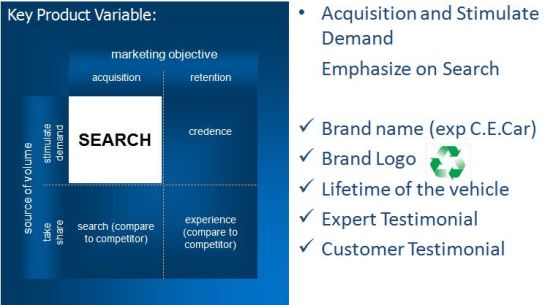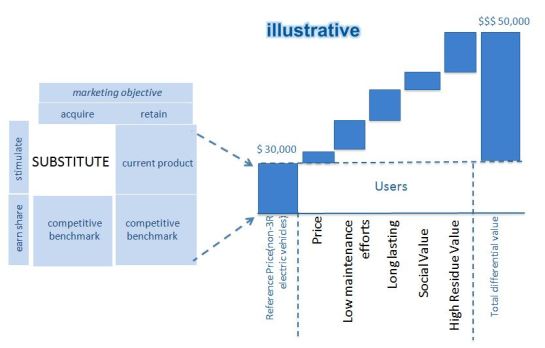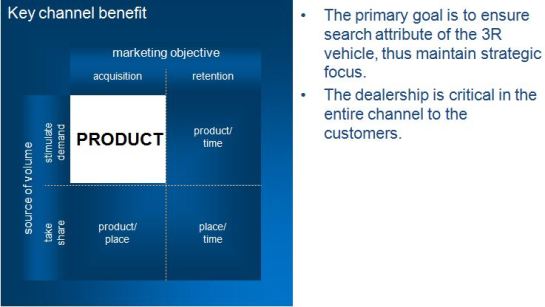Marketing Plan C.E. Cars based on Big Picture Framework
Marketing Plan C.E. Cars based on Big Picture Framework
Abstract
This a complete market plan which includes all the decision details and strategic alignments in each module, and evaluation metrics.
Project Description: Vehicle Design Based on the Circular Economy System
By Daniel Couttolenc
We live in a linear economy system where we take, we use and we dispose things creating a lot of waste in the process and at the end. Ideally a circular economy is where things don’t create waste which is the way nature works. A circular economy also refers to rethinking products so that they are designed with two types of materials: biological nutrients designed to reenter the biosphere safely and technical materials, which are designed to circulate without being disposed. There are a couple of possible ways to design a product with this type of materials. The first one is to design a product materials that decompose (biological nutrients) and over time it will turn into dust. The second way is to design a product with high quality materials (Technical materials) that are long-lasting, rebuildable, recyclable and/or reusable so they circulate without being disposed.
To design a car that creates absolutely no waste or pollution during its life-cycle is unrealistic but my design solution will explore alternative ways to create a cleaner car.
Module1 Business Objective
1. Fundamental Entity–who are we, what business are we in?
- Category Description
Recyclable, Reusable, Rebuildable (3R) Vehicle - Brand Line
Umbrella Branding - Product Portfolio
C.E. Car
2. Core Competence–what are we good at?
3. Goal–Where are we going?
Positional Benefit: High residual value. Who don’t want a car which worth up to 35% percent of the original price even after 10-year-driving?
- 100% percent market share of 3R eco-friendly vehicle
- 70% revenue growth
In a word, as the founder Daniel Couttolenc put it: “We will create a new segment between new and used cars, having the reliability of a new car and the price of a used one.”
Module 2 Market Objective
The customer definition with three ovals capture the potential customers’ attitude toward this 3R, long-lasting, high-residue value vehicle. Environmentalist is very likely to be the first adopter the new product, or consume such vehicle. In the peripheral oval, high residue value tend to be the benefit that acquire non-category customers, then long last (designed life expectancy of the car is 30 years) is the benefit that tends to lock in the acquired customers.
In the discussion with founder of the social venture Daniel, I identify the highest benefit and value to the customer would be the high residual value. This is the buzzword–your car’s value can be up to 35% of the original price even after ten-year-usage. Further since we plan position on the residual value on the an entire vehicle, so the components, which have low added-value comparing to an entire vehicle do not seem to be a good idea.
Below is the Customer Life Value calculation. The assumptions are below
The business model for this 3R vehicle is unique. Vehicle drivers buy the car from the company and then after certain years of usage, they can resell the car to the vehicle company at a very high percentage of the original car price, according to the founder of C.E. Car:”Depending on the condition of it, C.E. Car will be worth up to 35% of the original purchase price. This compares to the 12% resale of a typical car which is 10 years old.” This discrepancy is captured by the customers. After retrieve the car, With 3R material and the expertise of designing a 3R car, company will be re-selling several times the “same” component and will result in higher revenue. If the components are not qualified for reuse, they will be used as virgin raw material to manufacture new cars, rather than be sent straightly to the landfill.
In all, the company plans to return the surplus to the customers, the company profit from the circular use of materials, and the environments and society benefit from less impact of carbon and industrial waste.
Based on these assumption, CLV can be calculated.
Module 3 Source of Volume
To decide which category our business is in is of paramount importance. Considering the technical challenge, I think it might be imprudent to tap into the reusable, recyclable machine although the volume is gigantic. However, to limit the scope only on the low-end, low profit margin vehicle components is not advisable. Therefore, the category of 3R vehicle with medium market potential, seems to be a reasonable definition.

Then the 4B to calculate the volume and decide which strategic quadrant our business shall reside in.
According “Electric Vehicle Market Forecasts”, in the U.S., the number of hybrid and plug-in hybrid electric vehicles are estimated 1,222,220 in 2015 accounting for 5.1 percent of total domestic vehicle sales. Now the total number of vehicles in U.S. by 2015 is estimated 300,000,000. From the spreadsheet, it is clear that to define the targeted customer as the entire vehicle category in U.S. introduce significant higher volume, even there is only 5 percent of conversion rate. Thus the body, the targeted audience is any normal vehicle drivers, not necessarily limit to those environmentalists who manifest this point by purchasing a hybrid or entire electric vehicle. C.E. Car has strong value proposition, which is high residual value, to leverage to change behaviors.
This result matches with intuition that ACQ/STI is the way to go for a social venture. There are way too many vehicle components that are not 3R. Therefore, the activities required by strategic focus can be summarized as attract non 3R users into the category our company creates.
Value Laddering is employed to consolidate the features, benefits and value.
The key benefit on which we shall hammer, is the high residual value. The tag line would be, easy maintenance, more saving, live better.
Module 4 Segmentation
Although the strategic focus is Acquisition / Stimulate demand, STP tools can serve as an illustration of the perception and importance of the key features we have and the features and existing players have. i.e. use it in a Acquisition / Earn share approach. The Graph is from a industry incubator perspective. As Prof. Nordielm said, Big giants always keep an eye on these emerging threats, and tend to neutralize them as early as possible.
Plotting the market according the main variable(MV) and dynamic variable(DV). MV is defined the category leader, which is the non 3R electric vehicle manufacturing. here is high quality, endurability, carbon footprint, these benefits we must have. Dynamic variable is the benefit on which we are leverage to acquire the customers–ease of use, low cost, high residual value, energy efficient and environmental friendly.
High Residual Value versus Carbon Footprint
High Residual Value versus Performance
From the market plot above, clear is the outstanding benefit high residual value, and its important. The founder of C.E. Car Daniel found that a car now contain only 5% of the raw materials involved in the process of making and developing it, and after its average 10 years lifespan, the car may be worth a couple hundred dollars as scrap steel. With high residual value bestowed by C.E. Car, one can retrieve up to 35 % percent of original price back depending on the condition even after ten-year-usage.
Module 5 Targeting
Targeted Audience:
Module 6 Positioning
Each campaign can only have a positional benefit. Any vague message are supposed to be dismissed by target audience. In this 5 box of behavior change, the positioning statement seeks to remove the doubt of non-category user.
To be in tune with the change in the 5 box and targeted audience, the message and support type is changed accordingly. To stress on the ease of maintenance with 2R components, drama and story-telling of current customer seem to be a good approach.
One more consideration: to be distinguished from for profit model, social venture model should put more emphasis on social value. However, one would not buy a eco-friendly product simply because it protects the earth. Thus, I suggest pin down the utilitarian role– the ease in maintenance –in the first campaign which is characterized by acquisition and behavior change from “NO” to “YES”. Furthermore, it is obviously that the company will conduct more campaign with different positioning statement which in line with strategic focus in different stages. Specifically, when the company have established a stable and sufficient amount of users, it might consider a campaign featured an all 3R vehicle portfolio. At this stage, the strategic focus is Retention / Stimulate Demand, which plotted to remind the existing customer that all their needs can be fulfilled by company’s all kinds of 3R vehicle. A real world example is one of Audi’s commercial, in which all series of Audi vehicles Q, R, S, A are showcased.
Module 7 Product

To be aligned with the Acquisition/Stimulate Demand strategic focus, the SEARCH attribute is chosen among four quadrants. The search attribute emphasizes the ease of the potential customer in get to know of the product. For C.E. Cars, the name and logo of the product should established quick and solid association of the brand and company itself, as a possible logo from above. In addition, to testify the quality and life-expectancy of the C.E. car, the company may attend competitions, obtain certificates, or fulfill certain standards. To illustrate, the message could be a 3R vehicle is ABC award winning, ranked as the most promising green vehicle in XX auto show, and pass the EU VIII standards. And the high residual value, which is a experience oriented element, the company might ask the consumer to testify the quality and time, money saved by using a 3R vehicle.
Further the three dimensional attribute analysis of the product is laid out as follows:
 Again, aligned with the strategic focus in Acquisition/Stimulate demand, the pricing strategy should be chosen as trial pricing. Although the value is high, it is not advisable to start in high price and freak potential customers out.
Again, aligned with the strategic focus in Acquisition/Stimulate demand, the pricing strategy should be chosen as trial pricing. Although the value is high, it is not advisable to start in high price and freak potential customers out.
The highest cylinder represent the positional benefit.
The social venture manifest itself in that a proportion of value goes to society and environments.
Although C.E. Car pave out a brand new category as 3R electric vehicle, the price can be referenced to existing non-3R electric vehicle such as Toyato Prius, starting from $26,400. and plug in mode starting from 32,000. Therefore, the referenced cylinder is set as $30,000.
Module 9 Communication
The strategic focus on acquisition and stimulate demand demands the communication create the awareness. Reasonable the communication tactics is, since currently the task is to let the non-category users to adopt the product. First thing first is they heard of it, they knew it, they think positively of it, and finally, they buy it.
The following table records all the actions within possible communication channel along the purchase processes. For example, during the usage stage, the company might hold a party or club activities to strengthens the ties and a sense of belonging, create a favorable impression, and pave the way for the later retention/stimulate demand, which ask the existing users to purchase more.
Module 10 Promotion–Channel Alignment
Although it may seem to be verbose, the strategic focus requires the channel member to stress on the product, specifically on the assortment, depth of inventory, or selection. Each member of the channel has its own power, however, with value added along the channel, they can be aligned, as shown in the following table.
 With product in mind, the two channel members needs great incentive are dealership and sales representatives. We should invest more in training and motivating them get the right message of the product across and receive the complaints back.
With product in mind, the two channel members needs great incentive are dealership and sales representatives. We should invest more in training and motivating them get the right message of the product across and receive the complaints back.
In another dimension, the backward induction of the complaints or inquiries flow, the dealership’s power and incentive to withhold bad news, indicate that a special direct communication method should be established between the company and the customers. For example, BMW enables direct reporting procedures for the customers.
Module 11 Evaluation Metrics
A strategic might have dead in the water, if there were no clear metric to evaluate the execution each step of the way. In this module the strategy integration metrics are developed, operational metrics are set up along the consumption chain to ensure execution is a direct result of the company’s strategy. For instance, in the recognition phase, company can monitor the real progress of awareness creating, such as the inquiries received, hits on the videos or commercials that posted on YouTube. Or in the purchase and service phase, the company assign mysterious shoppers to maintain the in-store service quality.
End.
PS:
I would like to pay attribute to Prof. Nordhiem for the assistance and insightful comments throughout the course. I also thank the founder of C.E. Car Daniel, for providing such a great project for which to develop a social venture marketing plan. My thanks also goes to Marta Dapena-Baron, whose instructions on Entrepreneurial Marketing leaded me into the big picture framework.












